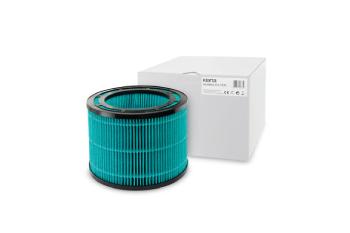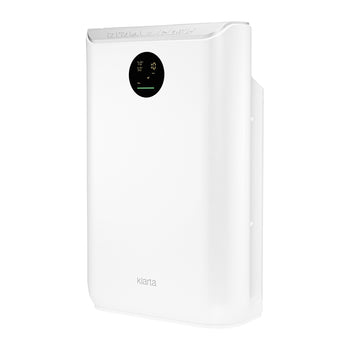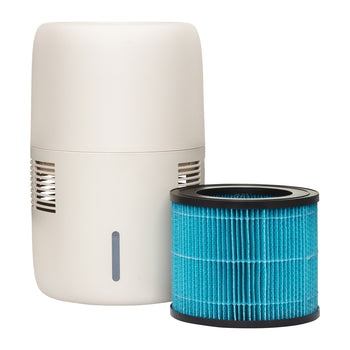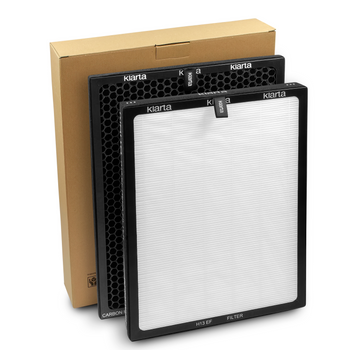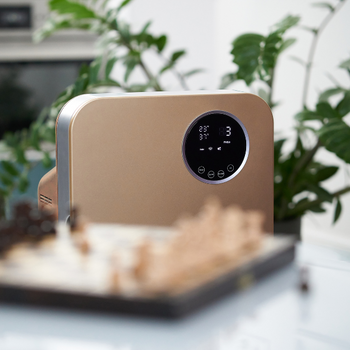
Purifier for asthma: 96% of asthmatics using Klarta purifiers have seen improvements in their well-being
What air purifier should an asthma sufferer buy? Does an air purifier help with asthma?
In a study Klarta Poland conducted between 2021 and 2022, 96% of asthma sufferers using our devices observed an improvement in their well-being. 32% reported a significant alleviation of asthma symptoms.
These numbers not only please us but also motivate us to continue improving our products. How do Klarta air purifiers help asthma sufferers?

Can an air purifier help alleviate asthma symptoms?
Equipped with effective H13 filters and strict auto mode, air purifiers significantly improve the quality of the air you breathe.
Air purifiers positively impact the health and well-being of asthma sufferers by significantly reducing the levels of smog particles, plant and animal allergens, and dust mites in indoor spaces. Consequently, they often reduce the need for asthma medications among patients.
Do air purifiers have negative effects on people with asthma?
So far, no negative effects of air purifiers on asthma sufferers and allergy sufferers have been found. Concerns related to this issue stem from the use of products whose by-product was ozone.
Modern air purifiers, including Klarta air purifiers, meet extremely stringent ozone emission standards. Therefore, they can be used without any worries by both adults and children.

Klarta user satisfaction study – improved well-being in 87 out of 91 asthmatics
At the end of 2021, we invited asthma sufferers who had purchased our products to participate in a study. In the survey, 91 asthma sufferers participated, and 87 of them reported an improvement in their well-being.
The vast majority of respondents confirmed the beneficial effects of our devices, with 29 people considering Klarta air purifiers very helpful in alleviating asthma symptoms.
The valuable feedback we gathered was used to introduce improvements in the new line of Klarta air purifiers, which we launched in early 2022. From the perspective of asthma and allergies, the most important changes are:
- Improved H13 EF 99.97% filters
- Even more stringent auto modes (3x Auto Mode)

Which air purifiers are best for asthma sufferers?
Those equipped with effective filters, primarily a H13 filter that traps:
- Dust mites (and their droppings)
- Plant pollen
- Molds and fungi spores
- Proteins in animal saliva
- Other allergens that exacerbate asthma symptoms
The air purifier should also respond quickly to rising pollution levels to promptly remove irritating substances from the air and restore breathing comfort.
Klarta air purifiers for asthma sufferers meet these conditions
Klarta Stor 2 and Klarta Forste 4 are modern air purifiers designed with allergy sufferers and asthmatics in mind, featuring:
Improved H13 EF 99.97% filters
The improved H13 EF filter has a larger surface area than the standard H13 filter, speeding up the process of purifying smog, allergens, and viruses.
The increased surface area of the filter material in EF filters also results in a 5-10% increase in air flow and purification rate compared to the standard H13 99.97% filter.
Why 99.97%?
The filtration material we use in our H13 filters achieves 99.97% efficiency against the most troublesome particles of 0.3 microns in size. Dust mites attach to dust particles, often reaching sizes of several microns. Such particles are easily trapped by our H13 and pre-filters.

Uncompromising approach to smog and allergens
The automatic mode is a key element of our air purifiers. Continuously developed since 2017, it ensures a swift response of Klarta purifiers to rising PM2.5 levels in the air.
This feature allows you to feel safe and free, without worrying about the air quality. Both Klarta Stor and Klarta Forste, designed in line with the latest WHO air quality guidelines, provide maintenance-free operation and clean air.
Benefits of using Klarta air purifiers
- Significant reduction in PM2.5 levels means less irritated respiratory systems
- Lower risk of lung infections
- Greater protection against secondhand smoke
- Enhanced quality of life
Do air purifiers cure asthma? No
Do they reduce pollutant levels that trigger bronchial asthma? Yes
An air purifier will never be a substitute for asthma medications but can improve the quality of life for asthma sufferers.
This is supported by studies conducted by researchers from Yonsei University in Seoul, Korea. The study involved 30 children with asthma, aged around 10, divided into two groups – one with active air purifiers and a control group (placebo). The groups were then switched so each child could use the purifier for three weeks.
Scientists compared PM2.5, CO2 levels, temperature, and humidity, then asked the participants about their well-being and medication doses while using the purifiers.
Interviews with the patients showed not only a decrease in PM2.5 levels in their environment but also a reduced need for asthma medication and positive changes in the urine microbiome (responsible for respiratory issues).
In another study involving young asthma patients from Fresno, California, researchers observed the effect of air purifiers over a 12-week period on average PM2.5 levels, asthma and allergy symptoms, and peak respiratory flow measurement.
There was about a 43% reduction in PM2.5 pollutants in their homes. Surveys showed a reduction in allergy and asthma symptoms.

Filter replacement in Klarta Forste air purifier is simple and takes about a minute.
Even the best air purifier can be ineffective if not used properly. Here are some key rules for using a purifier with allergies:
1. The air purifier should be on at all times to continuously remove smog and allergens from the air.
2. Don’t skip ventilating rooms. However, do it wisely – quick and intense ventilation (e.g., windows wide open for 5 minutes) is better than leaving windows open for a long time. After ventilating, you can manually select a higher purification speed to quickly remove allergens that entered through the open window.
3. Regularly clean the pre-filter with a cloth or a vacuum cleaner with a soft brush. Dust and hair on the pre-filter surface hinder air flow, slowing down the purification process.
4. The device will inform you when it’s time to replace the HEPA and carbon filters.
5. Place the purifier where nothing blocks the free air exchange. The best spot is on a flat floor in an open or semi-open space, at least 20 cm from the walls.
Dry air not only irritates the mucous membranes of the throat and nose but also provides a conducive environment for dust, including allergens, to remain airborne. Breathing such polluted air exacerbates symptoms in asthma sufferers.

Choosing a humidifier for an asthma sufferer
When selecting a humidifier for an asthma sufferer, focus on safety and hygiene. The Klarta Humea evaporative humidifier uses the healthiest evaporation technology – cold evaporation.
The water poured into the device is filtered and then released into the environment as an invisible mist. The convenient humidistat allows you to set the desired humidity level, ensuring the room doesn’t become overly humid.
Sources
1. Lee, Ga Hee et al. “Effects of Indoor Air Purifiers on Children with Asthma.” Yonsei Medical Journal, vol. 61, no. 4 (2020): 310-316. doi:10.3349/ymj.2020.61.4.3102.
2. Park, Hye-Kyung et al. “Effectiveness of air purifier on health outcomes and indoor particles in homes of children with allergic diseases in Fresno, California: A pilot study.” The Journal of Asthma, vol. 54, no. 4 (2017): 341-346. doi:10.1080/02770903.2016.1218011.
FAQ – Frequently Asked Questions
1. Are air purifiers worth buying for asthma sufferers?
Yes. Air purifiers can alleviate asthma symptoms, reduce the need for medications, and improve the well-being of asthma sufferers. Look for models that quickly respond to worsening air quality – equipped with appropriate sensors and stringent automatic modes.
2. How often should filters be replaced in air purifiers for asthma sufferers?
Filters in Klarta air purifiers should be replaced annually for the Klarta Forste model and every two years for the Klarta Stor model. However, if the device operates in a highly polluted environment (smog, cigarette smoke), more frequent replacements may be necessary.
3. High humidity and asthma? Does a humidifier make sense for asthma sufferers?
Absolutely. Besides purifying air from allergens, smog, and toxins, proper humidification is also crucial. Most homes in the United states struggle with low humidity, often dropping below 30% in winter. In such cases, air humidification can relieve strained respiratory systems in asthma sufferers. The optimal humidity level, healthy for users, is around 40-60%.
4. What worsens asthma?
Triggers for asthma attacks and symptom exacerbation include airborne allergens (plant pollen, dust mites, animal dander, mold), air pollution (aerosols, paint fumes, tobacco smoke), and respiratory infections. A good diet also helps. Eat regular meals, up to five times a day, focusing on whole grain products rich in fiber, vitamins, and minerals, and reduce the intake of fatty foods.


